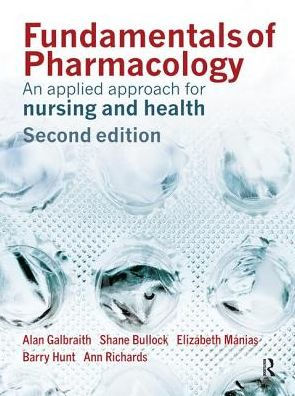Table of Contents
Glossary
Index
Brief contents
List of figures
List of tables
Preface
Acknowledgements
Section I Pharmacology within the social context
Chapter 1 An historical perspective
Chapter 2 Sociocultural aspects
Section II Pharmacology within the professional context
Chapter 3 Drug administration and the law
Chapter 4 Ethical issues
Chapter 5 The roles and responsibilities of nurses
Chapter 6 The roles and responsibilities of other health-care professionals
Section III Drug administration and professional responsibilities
Chapter 7 Drug formulations, storage and routes of administration
Chapter 8 The clinical decision-making process
Chapter 9 Drug administration strategies and documentation
Chapter 10 Medication errors
Chapter 11 Management of common adverse drug reactions
Section IV General aspects of pharmacology
Chapter 12 Drug nomenclature
Chapter 13 Pharmacokinetics: absorption and distribution
Chapter 14 Pharmacokinetics: metabolism and excretion
Chapter 15 Drug interactions
Chapter 16 Pharmacodynamics
Chapter 17 Drug development, evaluation and safety
Chapter 18 Pharmacogenetics
Chapter 19 Pharmacokinetic factors that modify drug action
Chapter 20 Paediatric pharmacology and pharmacology in older people
Section V Toxicology
Chapter 21 Poisoning and envenomation
Chapter 22 Management of clinical overdose
Chapter 23 Contemporary drugs of abuse
Chapter 24 Drug abuse in sport
Section VI Autonomic pharmacology
Chapter 25 General aspects of autonomic pharmacology
Chapter 26 Adrenergic pharmacology
Chapter 27 Cholinergic pharmacology
Section VII Chemical mediators
Chapter 28 Introduction to chemical mediators
Chapter 29 Histamine and antihistamines
Chapter 30 Prostaglandins and serotonin
Chapter 31 Nitric oxide and the endothelins
Section VIII Modulation of behaviour, cognition and motor activity
Chapter 32 General concepts of central nervous system pharmacology
Chapter 33 Antipsychotic drugs
Chapter 34 Anxiolytics and hypnotics
Chapter 35 Antidepressants and mood stabilisers
Chapter 36 Drugs used in neurodegenerative disorders
Chapter 37 Antiseizure drugs and muscle relaxants
Chapter 38 Central nervous system stimulants
Section IX Drugs used to relieve pain and produce anaesthesia
Chapter 39 Narcotic analgesics
Chapter 40 Non-steroidal anti-inflammatory, antipyretic and analgesic drugs
Chapter 41 General anaesthesia
Chapter 42 Local anaesthesia
Section X Modulation of oxygenation and perfusion
Chapter 43 Drugs used to lower blood lipids
Chapter 44 Antihypertensive drugs
Chapter 45 Drugs used to promote tissue perfusion
Chapter 46 Anticoagulants, thrombolytics and antiplatelet drugs
Chapter 47 Diuretics and other renal drugs
Chapter 48 Drugs used to treat cardiac insufficiency
Chapter 49 Fluid and potassium imbalances
Chapter 50 Antianaemic drugs
Chapter 51 Drugs used to maintain gas exchange
Chapter 52 Over-the-counter respiratory medicines
Section XI Modulation of gastrointestinal function
Chapter 53 Upper gastrointestinal tract drugs
Chapter 54 Lower gastrointestinal tract drugs
Chapter 55 Nausea and vomiting
Section XII Modulation of body growth, development and metabolism
Chapter 56 Drugs and the pituitary gland
Chapter 57 The thyroid and the pancreas
Chapter 58 The adrenal cortex and the gonads
Chapter 59 Hyperuricaemia and gout
Chapter 60 Obesity
Section XIII Nutritional and natural therapies
Chapter 61 Vitamins
Chapter 62 Minerals
Chapter 63 Amino acids
Chapter 64 Enteral and parenteral nutrition
Chapter 65 Herbal medicines
Section XIV Modulation of cellular growth and proliferation
Chapter 66 Introduction to chemotherapy
Chapter 67 Sulphonamides and trimethoprim
Chapter 68 Antibacterial drugs
Chapter 69 Antituberculotic and antileprotic drugs
Chapter 70 Antiseptics and disinfectants
Chapter 71 Antiparasitic drugs
Chapter 72 Antimalarial drugs
Chapter 73 Antiviral drugs
Chapter 74 Antifungal drugs
Chapter 75 Vaccines and immunomodulating drugs
Chapter 76 Cytotoxic drugs
Chapter 77 Gene therapies
Section XV Drugs used topically
Chapter 78 Drugs used in diseases of the skin
Chapter 79 Drugs and the eye
Appendix A Common prescription terminology
Appendix B Common US generic drugs names
Appendix C SI units
Appendix D Drug calculations
Appendix E Common symbols used in medication charts
Appendix F Common word mix-ups
Appendix G Drug–herb interactions
Appendix H Orphan drugs
Glossary
Index






